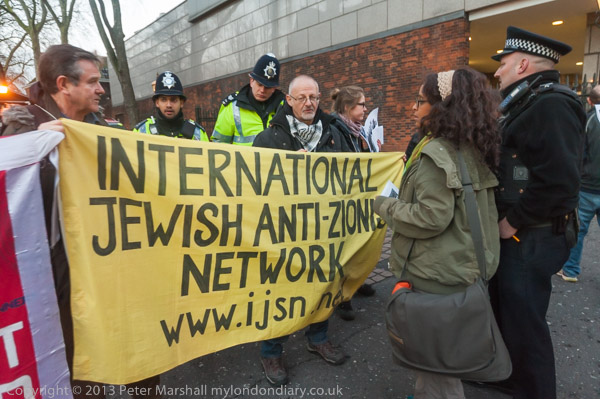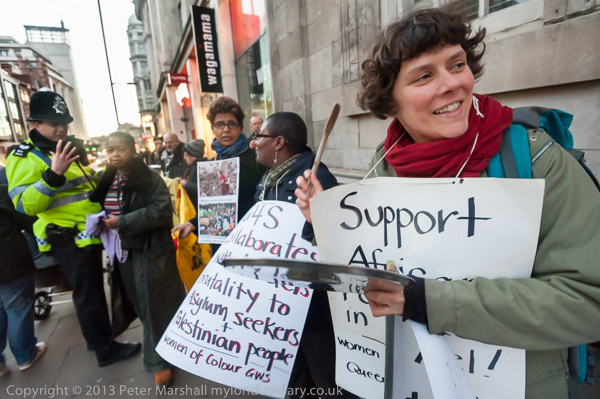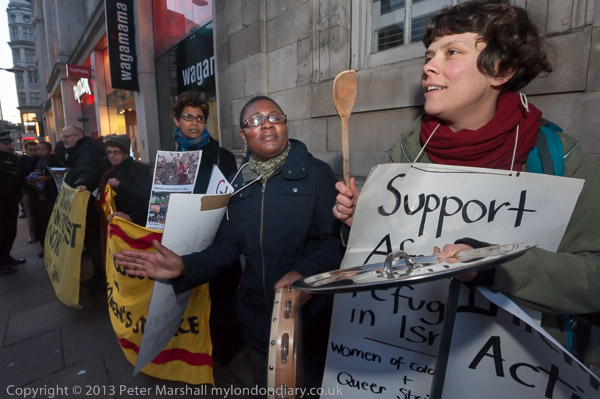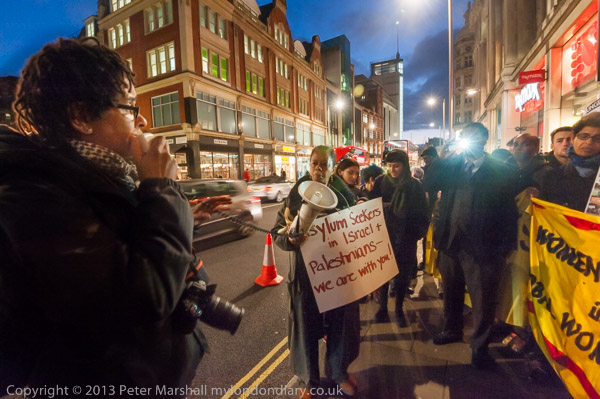Solidarity with African Refugees in Israel was the third protest I managed to photograph on Wednesday 22 Jan, after starting shortly after 11am at the Irish Embassy for Release Margaretta D’Arcy Now!, and then going on to Malet St to photograph the Student march to protect Education. It was a long day for me, although it perhaps wouldn’t seem much if I said I was actually taking pictures for around four hours, I also spent another roughly three hours travelling, and then probably five or six hours editing the images and writing and posting the three stories, it all adds up to around 13 hours.
Few photographers spend the time I do editing their work or writing stories. It doesn’t pay. To increase the chances your pictures will be used you need to file them within minutes of taking them. This often means filing almost before the event has started – take a few pictures, file, then if you have time and it looks as if something interesting might happen and you don’t have another story to cover, perhaps hang around and take a few more.
I prefer to take pictures until either the event finishes or I have to leave, then think about them and how they relate to the event before I file them. I do more post-processing than most photographers, though I try to be careful not to let it show. I want the colour balance and contrast to be how I see them, and to dodge and burn to get the tonal right too. Of course I don’t add or subtract content, and my aim is always to get the image to work , to convey what I was trying to convey when I took it.

The protest was in support of African asylum seekers detained without trial in Israel who are on hunger strike
Back to that Wednesday, by the time I got to the protest opposite the Israeli Embassy it was 4.30pm, more or less sunset, though the sun had mainly long disappeared behind the buildings of Kensington High St, and I was working in twilight. Fortunately the protesters had chosen to defy the police and set up on the lighter side of the street, in front of the road on which the embassy stands. Occasionally you can just see an Israeli flag flying if you look down on the left, but I think they often take it down when protests are expected, and I don’t think it was there.
I started with taking pictures at ISO 1600, but soon the light was falling quickly, and to get reasonable shutter speeds I had to increase the ISO setting, ending up within around 15 minutes at ISO 3200.

Police try to get protesters to move across the road. They agreed not to block access but stayed
This was a fairly lively protest, and most of the pictures were taken at 1/80th second. Using wide-angles as I mainly do, slower shutter speeds can give sharp images and camera shake would seldom be a problem even at 1/15th – especially if I remembered to check that image stabilisation was on with the 16-35mm, but many parts of the image would be blurred unless people were standing still and quiet.

Available light, D700 16mm (16-35 zoom)
There is just a little blur at the left and around three quarters of the way up the frame in some of these images – due to a small greasy mark on the lens which wasn’t really noticeable in the viewfinder or display on the back of the camera. Nor for that matter did it really show up when I looked at the front of the lens, though it was there if you looked carefully.
It’s possible to reduce the diffusion that this creates, using Lightroom‘s Adjustment brush with a little added contrast and ‘clarity’ and sometimes a little decrease in ‘highlights’ and adjusting the ‘exposure’ settings on the brush helps too, but it doesn’t quite disappear, though it is perhaps unlikely to be noticed by most. I’ve perhaps left it a little too light in the image above.

A minute later, same lens & camera, with SB800 flash
I took some pictures with available light and then switched to flash, working in Shutter priority mode with shutter speeds of 1/30 to 1/80s. The difference between the two pictures above, taken around a minute apart is fairly obvious. The available light image makes it look lighter than it was, but the lighting is much more even. With flash, using a single SB800 unit on the hot shoe, there is a very obvious falling off in the flash illumination, even though I’ve burnt in the closer parts of the scene to compensate to some extent.
The upper image actually makes it look rather lighter than it was when I took the picture – probably I should have made it darker – it hardly looks as if it was getting dark at all. The flash picture is better in this respect, and the uneven lighting concentrates attention on the nearest figure, the woman bashing the pan lid. The upper image is more about the overall scene, with the policeman’s hand in particular claiming our attention; together with the expression on the face of the woman closest to the camera it makes a more interesting image.
Both were taken with the 16-35mm at its widest on the D700. In available light I was using Program mode at ISO 2800 at f4. There is greater depth of field in the flash image, as this was taken using Aperture priority at f8. Looking at larger images the wooden spoon is a little blurred in the upper image (at 1/80s) but pin sharp with the flash. In part this is because it was not actually moving when I took the picture, because although the short flash duration would have made it sharp in any case, there would have also been a blur with the ambient exposure. It’s an effect that might have improved the image, and one that you can see in some of the other pictures in Solidarity with African Refugees in Israel.
The effect of flash falls off dramatically with distance – roughly following the ‘inverse square law’ which states that if the distance doubles the amount of light drops by a factor of four. You can minimise the effect by trying to keep everything more or less the same distance away, for example by taking a group with a banner from directly in front, but that tends to be rather static and boring. One small trick is to try and make use of the natural fall-off in flash illumination towards the edges of its coverage, by swivelling the flash head away from the closer parts of the subject, but most flash images require considerable burning in of the closer parts and brightening up of the more distant areas.

Wherever possible I like to use available light, as it usually preserves more of the atmosphere of the scene, as well as often cutting down on the post-processing required. By the time I finished taking pictures at this protest, around 40 minutes after sunset, twilight had passed and most of the available light came from the street lighting. In the final picture I took, this was augmented a little by a man in the picture with a light on his camcorder. Working at 1/15s at ISO 3200 I had an exposure bias of -1.33 stops to get it to look like night, so the real ISO was around ISO 10,000 and set the aperture at f8 to give me sufficient depth of field from the speaker I was standing next to right to the street behind at 16mm.
It’s sharp but very noisy, but the noise on the D700 (and D800E) has a quality that reminds me of film grain, though more even, and I think in this image is attractive. Rather less so are the horizontal streaks that the Nikon sensor gives in highly underexposed areas, but these are hardly noticeable here even in the full-size image, and making those areas a little darker would reduce the effect further. In this case, mainly because of very uneven lighting, quite a lot of post-processing was needed.
______________________________________________________
My London Diary : Buildings of London : River Lea/Lee Valley : London’s Industrial Heritage
All photographs on this and my other sites, unless otherwise stated, are taken by and copyright of Peter Marshall, and are available for reproduction or can be bought as prints.
To order prints or reproduce images
________________________________________________________